


Haʻapai is a group of islands, islets, reefs, and shoals in the central part of the Kingdom of Tonga. It has a combined land area of 109.30 square kilometres (42.20 sq mi). The Tongatapu island group lies to its south, and the Vavaʻu group lies to its north. Seventeen of the Haʻapai islands are inhabited. Their combined population is 5,419. The Ha‘apai group’s highest point is Kao, which is almost 1,050 metres (3,440 ft) above sea level.
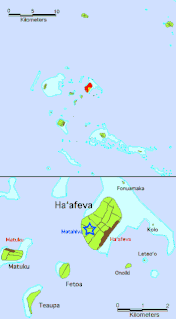
Haʻafeva is a small island in the Haʻapai group of Tonga, but still the main island of the Lulunga archipelago. Kolongatata is the name commonly given to the village on Haʻafeva and is a reference to Haʻafeva's exposure to strong winds. The inhabited area of Haʻafeva can be divided into Hahake, Hihifo, Tuʻa Kolo, Loto Kolo and Uta. The Island has a population of about 200.

ʻEua is an island in the kingdom of Tonga. It is close to Tongatapu, but forms a separate administrative division. It has an area of 87.44 km2 (33.76 sq mi), and a population in 2021 of 4,903 people.

Matuku is a tiny island in Lulunga, a part of Haʻapai in Tonga. It is easily reached by outboard motorboat from the neighbouring hub of Haʻafeva and is on the course from there to the culturally important island of Kotu.

Metis Shoal, also known as Lateiki Island, is a volcanic island at the top of a submarine volcano in Tonga, located between the islands of Kao and Late. The current island formed in October 2019, when a smaller island disappeared after 24 years.
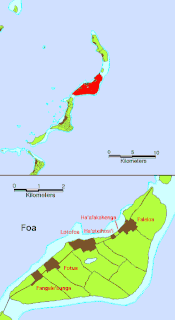
Foa is an island in Tonga. It is located within the Haʻapai group in the centre of the country, to northeast of the national capital of Nukuʻalofa.

Lifuka is an island in the Kingdom of Tonga. It is located within the Haʻapai Group in the centre of the country, to northeast of the national capital of Nukuʻalofa.
Lofanga is an island in Tonga. It is located within the Ha'apai Group in the centre of the country, to northeast of the national capital of Nukuʻalofa. The island had a population of 137 at 2016, and an area of 1.45 km2.
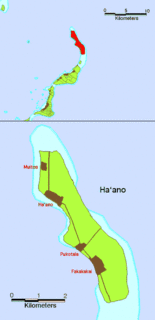
Haʻano is an island in the Haʻapai islands of Tonga. To the south are the islands of Foa and Lifuka.
Fotuhaʻa is an island in Lifuka district, in the Haʻapai islands of Tonga. As of 2020, the population is estimated at approximately 100-150 and an area of 1.14 km2.
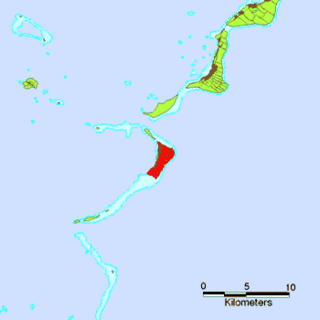
ʻUiha is an island in Lifuka district, in the Haʻapai islands of Tonga. It had a population of 638 in 2006 and an area of 5.36 km2 (2.07 sq mi).
Kito is an island in the Lulunga district, part of the Ha'apai islands of Tonga.
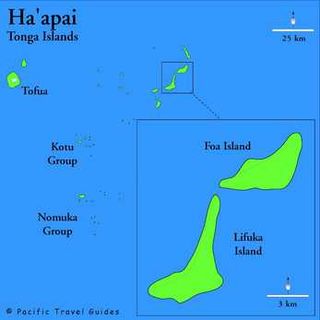
Pangai is the administrative capital village of the Haʻapai Group in Tonga.
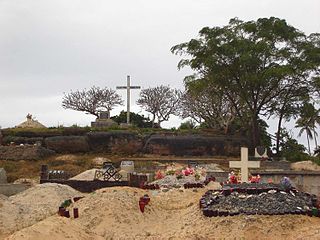
Fatafehi Laufilitonga was the 39th and last Tuʻi Tonga, a dynasty of kings in Tonga during the Tuʻi Tonga Empire.
Teaupa is an island in Lulunga district, in the Ha'apai islands of Tonga.

Tungua is an island in Lulunga district, in the Ha'apai islands of Tonga. The island had a population of 187 in 2016.
Fangale'ounga is a settlement in Foa island, Tonga. It had a population of 140 in 2016.

Faleloa is a settlement in Foa island, Tonga. It had a population of 380 in 2016.
The consumed scrubfowl is an extinct megapode that was native to Fiji and Tonga in the south-west Pacific Ocean. It was originally described from subfossil remains collected by David Steadman from an archaeological site at Tongoleleka, on the island of Lifuka in the Haʻapai group of the Kingdom of Tonga. The specific epithet and vernacular name refer to its evident use as a food item. Subsequently, remains were also found on Lakeba and Mago in the Lau group of Fiji by Trevor Worthy. It likely became extinct through overhunting following human settlement of the islands some 3,500 years ago but may have persisted until the mid-late 19th century: